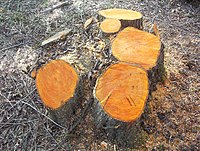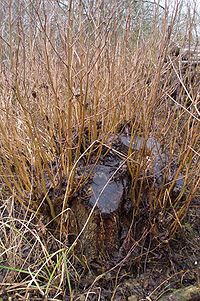silvicultural technique in which trees are cut at the ground and allowed to re-sprout from the stumps. Used to produce biomass. fuelwood. or poles of a particular specification. Sometimes described as basal pollarding (contrast with pollarding).
Coppicing is a traditional method of woodland management which exploits the capacity of many species of trees to put out new shoots from their stump or roots if cut down. In a coppiced wood, which is called a copse, young tree stems are repeatedly cut down to near ground level, known as a stool. New growth emerges and after a number of years, the coppiced tree is harvested and the cycle begins anew. Pollarding is a similar process carried out at a higher level on the tree.
Many silviculture practices involve cutting and regrowth; coppicing has been of significance in many parts of lowland temperate Europe. The widespread and long-term practice of coppicing as a landscape-scale industry is something that remains of special importance in southern England. Many of the English-language terms referenced in this article are particularly relevant to historic and contemporary practice in that area.
Typically a coppiced woodland is harvested in sections or coups on a rotation. In this way, a crop is available each year somewhere in the woodland. Coppicing has the effect of providing a rich variety of habitats, as the woodland always has a range of different-aged coppice growing in it, which is beneficial for biodiversity. The cycle length depends upon the species cut, the local custom, and the use to which the product is put. Birch can be coppiced for faggots on a three- or four-year cycle, whereas oak can be coppiced over a fifty-year cycle for poles or firewood.
Coppicing maintains trees at a juvenile stage, and a regularly coppiced tree will never die of old age; some coppice stools may therefore reach immense ages. The age of a stool may be estimated from its diameter, and some are so large—perhaps as much as 5.4 metres (18 ft) across—that they are thought to have been continually coppiced for centuries.


